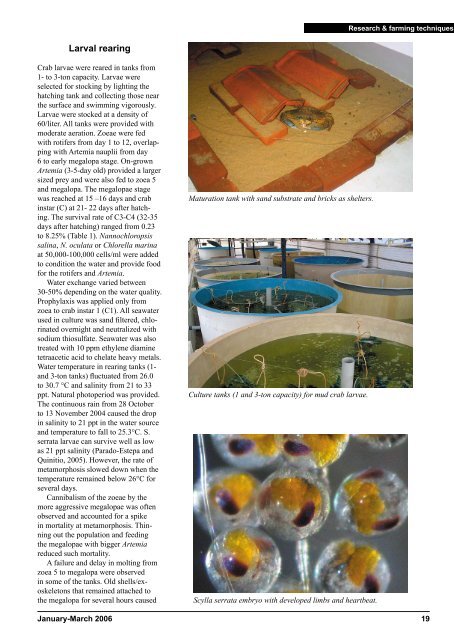Farming carps in leased ponds, Bangladesh - Library - NACA
Farming carps in leased ponds, Bangladesh - Library - NACA
Farming carps in leased ponds, Bangladesh - Library - NACA
Create successful ePaper yourself
Turn your PDF publications into a flip-book with our unique Google optimized e-Paper software.
Larval rear<strong>in</strong>g<br />
Crab larvae were reared <strong>in</strong> tanks from<br />
1- to 3-ton capacity. Larvae were<br />
selected for stock<strong>in</strong>g by light<strong>in</strong>g the<br />
hatch<strong>in</strong>g tank and collect<strong>in</strong>g those near<br />
the surface and swimm<strong>in</strong>g vigorously.<br />
Larvae were stocked at a density of<br />
60/liter. All tanks were provided with<br />
moderate aeration. Zoeae were fed<br />
with rotifers from day 1 to 12, overlapp<strong>in</strong>g<br />
with Artemia nauplii from day<br />
6 to early megalopa stage. On-grown<br />
Artemia (3-5-day old) provided a larger<br />
sized prey and were also fed to zoea 5<br />
and megalopa. The megalopae stage<br />
was reached at 15 –16 days and crab<br />
<strong>in</strong>star (C) at 21- 22 days after hatch<strong>in</strong>g.<br />
The survival rate of C3-C4 (32-35<br />
days after hatch<strong>in</strong>g) ranged from 0.23<br />
to 8.25% (Table 1). Nannochloropsis<br />
sal<strong>in</strong>a, N. oculata or Chlorella mar<strong>in</strong>a<br />
at 50,000-100,000 cells/ml were added<br />
to condition the water and provide food<br />
for the rotifers and Artemia.<br />
Water exchange varied between<br />
30-50% depend<strong>in</strong>g on the water quality.<br />
Prophylaxis was applied only from<br />
zoea to crab <strong>in</strong>star 1 (C1). All seawater<br />
used <strong>in</strong> culture was sand fi ltered, chlor<strong>in</strong>ated<br />
overnight and neutralized with<br />
sodium thiosulfate. Seawater was also<br />
treated with 10 ppm ethylene diam<strong>in</strong>e<br />
tetraacetic acid to chelate heavy metals.<br />
Water temperature <strong>in</strong> rear<strong>in</strong>g tanks (1-<br />
and 3-ton tanks) fl uctuated from 26.0<br />
to 30.7 °C and sal<strong>in</strong>ity from 21 to 33<br />
ppt. Natural photoperiod was provided.<br />
The cont<strong>in</strong>uous ra<strong>in</strong> from 28 October<br />
to 13 November 2004 caused the drop<br />
<strong>in</strong> sal<strong>in</strong>ity to 21 ppt <strong>in</strong> the water source<br />
and temperature to fall to 25.3°C. S.<br />
serrata larvae can survive well as low<br />
as 21 ppt sal<strong>in</strong>ity (Parado-Estepa and<br />
Qu<strong>in</strong>itio, 2005). However, the rate of<br />
metamorphosis slowed down when the<br />
temperature rema<strong>in</strong>ed below 26°C for<br />
several days.<br />
Cannibalism of the zoeae by the<br />
more aggressive megalopae was often<br />
observed and accounted for a spike<br />
<strong>in</strong> mortality at metamorphosis. Th<strong>in</strong>n<strong>in</strong>g<br />
out the population and feed<strong>in</strong>g<br />
the megalopae with bigger Artemia<br />
reduced such mortality.<br />
A failure and delay <strong>in</strong> molt<strong>in</strong>g from<br />
zoea 5 to megalopa were observed<br />
<strong>in</strong> some of the tanks. Old shells/exoskeletons<br />
that rema<strong>in</strong>ed attached to<br />
the megalopa for several hours caused<br />
January-March 2006<br />
Maturation tank with sand substrate and bricks as shelters.<br />
Culture tanks (1 and 3-ton capacity) for mud crab larvae.<br />
Scylla serrata embryo with developed limbs and heartbeat.<br />
Research & farm<strong>in</strong>g techniques<br />
19

















